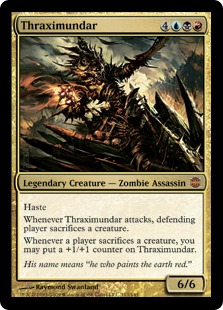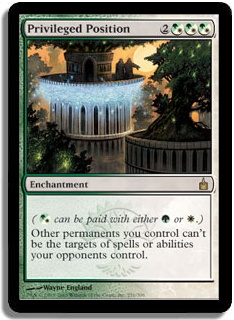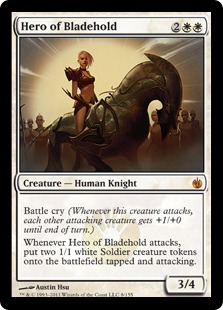Writing Magic finance articles has its perks; besides getting paid to talk about an aspect of Magic that I love, I also get the opportunity to buy more cards than I have money for. Buying cards at vendor prices is always the goal for grinders. What some people don’t realize is that you don’t need to buy at dealer prices to make money. Before I started writing about Magic finance, I was a grinder working the trade tables. I didn’t have access to the opportunities that I do now, but I was still able to make money using the concepts of “Perceived Value” and “Trading for Cash.”
When I first started trading, I felt like selling to a dealer was the worst thing that I could do. I’d ask myself, “Why would I sell my cards for 50% of what they’re worth when I can get so much more by selling them myself?” This question kept me away from the dealer table for quite a while, but I eventually discovered the untapped power of the buylist. I wont be going over all the intricacies of working with buylists. There’s a lot of information here, but it would require me to talk in-depth about vendors and their buyer configurations, which wouldn’t be appropriate for this column. I hope the last couple sentences will encourage you to look into these topics deeper. Instead of all that, I want to focus on how to use a buylist to trade for cash.
Trading for Cash
I’m not talking about trading other players for cash; that’s a good way to get you kicked out of an event. I’m talking about trading the dealers for cash. I still remember the first time that I sold to a dealer. I was talking with another grinder about trading strategies, and he said something like, “Did you know that StarCityGames.com is paying $2 on Chandra Nalaar?” I acted like I did know and said, “Ship, ship, ship!” His comments piqued my interest, and I planned to stop by the dealer booth before I left.
I was getting $2 for Chandra Nalaar on Magic Online Trading League (MOTL); why would I hassle with the shipping if I could just sell these to SCG now? After a handful of trades, I made my way to the SCG booth. Ben Bleiweiss opened my binder and made me some offers. I decided to only sell cards if the offer was equal to what I could get on MOTL. We worked our way through my trade stuff, and before I knew it I had a few hundred dollars in sales.
This first sitting was eye opening for me. I noticed that some of the offers that Ben made were close to the perceived value of certain cards. Perceived value is a concept that I introduced in my Robocop-style card evaluation articles. I included it as a metric for judging a card, but I’ve never given a full explanation of how to use it.
The best way to explain this is to walk through the concept in action. Let’s say that you open a binder and you see a Thraximundar. Can you tell me what it’s worth without looking it up? Unless you’re a Commander player, you probably won’t be able to give an accurate price. Thraximundar typically trades for under $4; this is based on my experience at the trade tables. Experience is the only metric that we have to measure “perceived value,” so navigating these values is much more of an art than a science.
Thraximundar is priced at $8 (and sold out) here at StarCityGames.com, but you don’t have to use SCG as your pricing metric. You should research as many different pricing sources as you can. If you check the prices for Thraximundar around the web, you’ll see that it ranges from $4 to $8.* It’s important to know these values so that you know where your pricing fits in contrast to the retail prices.
Trades are typically based on each person’s intuition (unless you have a rep for being scummy; then you’re going to get iPhoned every time you trade). This is why it’s important for a trader to have a strong understanding of the perceived value. If a smart phone is introduced to the equation, then you should be ready to navigate the different pricing sources and give support for your offers. In navigating the pricing sources, you need to find the highest EV exchange. If you’re trading the card away, then you want to value it close to the highest vendor price you can find, and if you’re trading for the card, then you want to reference the lowest price you can find. This is the typical “buy low, sell high” strategy. Let’s develop the concept further.
Trading for cash is simply acquiring cards that have a perceived value with less than or equal to its buylist price. This is where we can get into a little bit of ethical trouble. If you’ve followed my writing for any amount of time, then you know that according to the trolls, I’m the king of all scumbags. One of the problems that people have with value trading is the approach that grinders take for extracting value. I’m not here to tell you how to live your life, but If you care about your reputation as a trader, then you should be careful of how you present yourself on the trade floor and how you translate this information to your trade partner. There are two ways that you can approach this:
“What do you value this at?”
This way can be more profitable (depending on how out of touch your trade partner is), but it rubs people the wrong way. This phrase doesn’t always mean bad news, but it can be used in an aggressive manner. When I use this phrase, it’s only to get a feel for my trade partner’s valuation compass. Some people use it to quiz their trade partner and punish them for wrong answers. For example:
“What do you value this Thraximundar at?”
“I dunno, $2?”
“Okay, and how about the Sarkhan Vol?”
“$5.”
“The other card I was interested in was the Master Transmuter. What do you got on that?”
“I think it’s $4.”
“Okay, I’ll take the Thraximundar and the Sarkhan Vol, and I’ll pass on the Master Transmuter.”
This person sold himself short on the Thraximundar and the Sarkhan Vol. In this strategy, the perceived value acts as a guide. The grinder doesn’t want to ask their trade partner how much they think everything is in the trade binder. Instead the grinder focuses on the cards that have a perceived value that are equal to, or less than, the buylist price. This will maximize the value that the grinder can extract from this transaction.
You can see why this method rubs people the wrong way. Here the grinder wants to present as a regular trader who’s looking to do a “fair” trade but is really only looking to extract value.
This is why my advice to everyone is to enter each trade with caution. My advice to traders/grinders is to avoid this strategy. You can get the same result and build a good reputation by simply presenting yourself as dealer or value trader.
“I can offer $3 on this.”
The difference here is that your trade partner understands that you are trying to extract value. This strategy also uses the perceived value as a guide. It gives you an idea of which cards people will ship and which ones you might have to offer more on. It gives you the same information as above, but you use that information differently in this strategy. Instead of trying to punish your trade partner, you’re trying to make the best offer that you can to increase your chances of success. This is how this strategy might look in conversation form:
“I do a lot of buying and selling of cards, so I’m looking for stuff that I can sell or trade for value. The way that I do this is that I’ll make you offers on some cards, and if you like them let me know. Okay?”
“Okay.”
“I can offer $3 on Thraximundar, $6 on Sarkhan Vol, and $2 on Master Transmuter.”
“Isn’t Thraximundar like $8?”
“On SCG they are, but I’ll probably list it for sale at $4-5.”
“Okay, those numbers are fine.”
In this strategy there is no deception, but you’re still trading for cash, and you are still using perceived values as a guide. Even if your trade partner keeps the Thraximundar here, you still win.
The Missing Link
We’ve put some of the pieces together in this trading for cash concept, but we’re missing a critical element. The most important thing to know when trading for cash is what type of cards to target. Why are we talking about cards like Thraximundar and Master Transmuter? We’re looking for cards that have a decent buylist price but don’t see a lot of Constructed play. There are two reasons for this:
1) If the card is not a hot ticket item, then chances are that it’s been in your trade partner’s binder for a long time, and they’ll be more willing to let it go for less than retail.
2) The perceived value of cards that don’t see play in Constructed is typically much lower than the retail value. This means that the trade values will be more in sync with buylist prices and more compatible with your goals.
I’ve gone through some of the Modern sets to come up with a list of cards that are perfect targets for trading for cash. Some of these are more known than others; for example it’s no secret to a seasoned grinder that the Eventide Lieges are worth something. If I listed a card here, it’s because I think you can get it for the buy price or less. All the buy prices are based on the StarCityGames.com buylist. Keep in mind that these prices can vary between different vendors’ buylists. I encourage you to do some studying and learn the ins and outs of as many buylists as you can.
Mirrodin
Extraplanar Lens $2
Mind’s Eye $3
Sword of Kaldra $2
Darksteel
Forge[/author]“]Darksteel [author name="Forge"]Forge[/author] $5
Leonin Shikari $1
Memnarch $1
Mycosynth Lattice $2
Myr Matrix $1
Panoptic Mirror $1
Pristine Angel $1
Shield of Kaldra $1
Fifth Dawn
Auriok Champion $1
Beacon of Immortality $1
Beacon of Unrest $1
Helm of Kaldra $2
Mephidross Vampire $3
Vedalken Orrery $2
Champions of Kamigawa
Azusa, Lost but Seeking $1
Eight-and-a-Half-Tails $1
Journeyer’s Kite $1
Marrow-Gnawer $1
Minamo, School at Water’s Edge $1
Betrayers of Kamigawa
Ink-Eyes, Servant of Oni $5
Mirror Gallery $1
That Which Was Taken $1
Saviors of Kamigawa
Erayo, Soratami Ascendant $3
Mikokoro, Center of the Sea $1
Miren, the Moaning Well $2
Sakashima the Impostor $2
Ravnica: City of Guilds
Circu, Dimir Lobotomist $1
Privileged Position $3
Guildpact
Dissension
Grand Arbiter Augustin IV $2
Voidslime $1
Coldsnap
Adarkar Valkyrie $3
Braid of Fire $2
Thrumming Stone $2
Dragonstorm $1
Gauntlet of Power $3
Stuffy Doll $3
Undead Warchief $1
Dryad Arbor $1
Jhoira of the Ghitu $1
Lorwyn
Deathrender $1
Immaculate Magistrate $2
Imperious Perfect $2
Vigor $3
Idyllic Tutor $3
Leaf-Crowned Elder $1
Preeminent Captain $2
Stonehewer Giant $2
Eventide
Balefire Liege $2
Creakwood Liege $3
Deathbringer Liege $3
Divinity of Pride $3
Murkfiend Liege $2
Necroskitter $2
Primalcrux $1
Scarecrone $1
Shadowmoor
Greater Auramancy $2
Mana Reflection $3
Rhys the Redeemed $3
Shards of Alara
Death Baron $4
Godsire $2
Sarkhan Vol $6
Master Transmuter $2
Reliquary Tower $1
Alara Reborn
Dragon Broodmother $2
Mind Funeral $1
Thraximundar $3
Zendikar
Rise of the Eldrazi
Khalni Hydra $2
Kozilek, Butcher of Truth $6
Nirkana Revenant $3
Ulamog, the Infinite Gyre $5
Worldwake
What does it look like?
This article is intended to fill a hole in the puzzle Magic finance. I’ve written articles about the pricing trends of different cards, but there’s been some confusion about how to extract the value from a card that has gone up in price. For example, let’s pretend that I bought a Hero of Bladehold at $10, and now it’s $18. How do I get that $8 out of it? This is what getting value would look like; I’ll set the stage. Your trade partner opens your binder and says…
“I’m interested in the Hero of Bladehold.”
“Okay, I’m looking to get about $15 to $18 on it. Is that okay?” (This is a high-profile card, so its perceived value is in sync with its retail value. That’s why this works.)
“Yeah.”
“Okay, I’ll go through your binder and make some offers, and you can let me know which ones are okay.”
After some back and forth, you might end up with something like this:
1 Forge[/author]“]Darksteel [author name="Forge"]Forge[/author]
1 Ink-Eyes, Servant of Oni
4 Reliquary Tower
1 Necroskitter
It doesn’t look like much, but you can take these to SCG and sell them for $16 cash. It’s like you just sold the Hero of Bladehold, and you didn’t risk getting kicked out of the event to do it. What’s important here is the concept, not the trade that I outlined above. It’s all about finding the cards that have a low perceived value and a high buy price. Your homework is to troll some buylist and make yourself a list of targets. That’s all I have for you this week. Thanks for reading!
* I don’t think SCG is overpriced here. It looks like other vendors are actually behind on this trend. I was tempted to buy out all the vendors that are selling this card for $4-5, but I decided to leave them so you can see the data. Don’t be surprised if they sell out a couple days after this article is posted.



